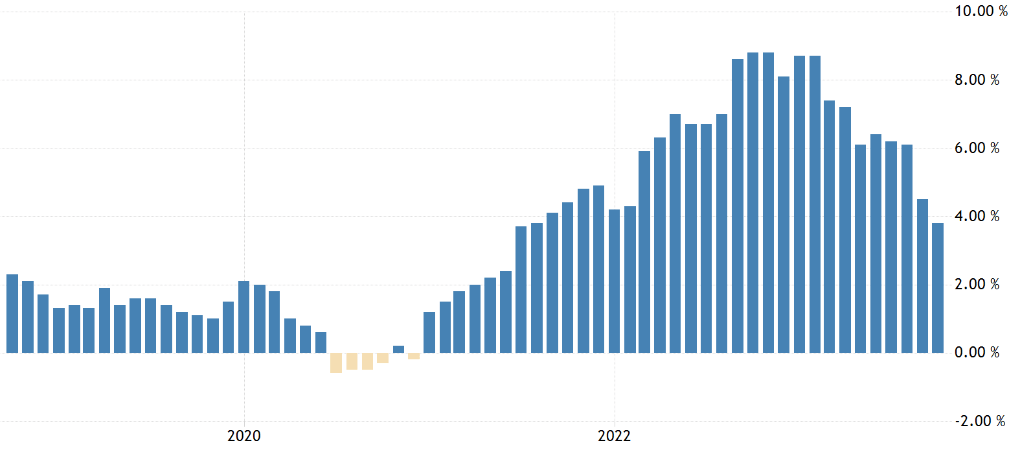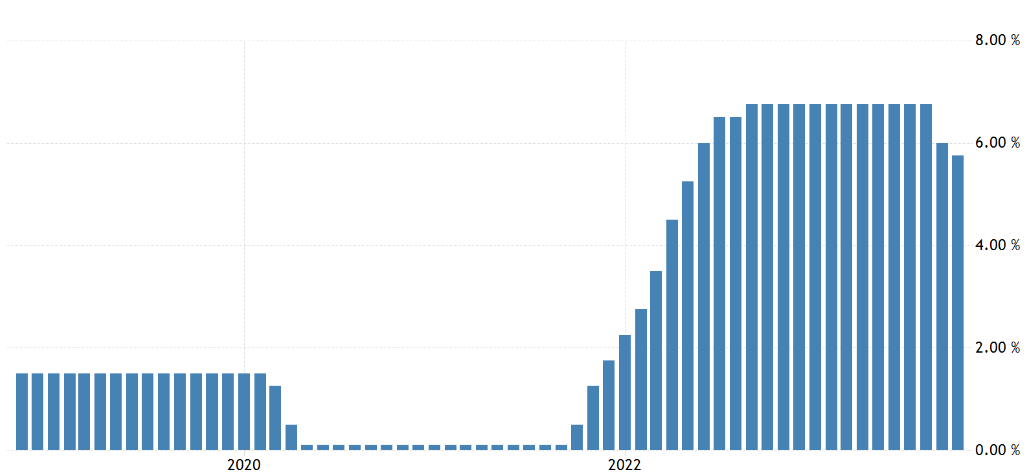Most of the major companies have already reported their third-quarter results, while next week, we will be able to learn more about companies such as Berkshire Hathaway, Walt Disney and AstraZeneca. On the macroeconomic front, October inflation data will be released from Germany, and the National Bank of Poland will vote on whether to continue its rate cutting path. Meanwhile, the UK will release Q3 GDP growth data.
Table of contents:
- Germany Consumer Price Index (CPI) YoY (October)
- Poland Interest Rate Decision
- UK Gross Domestic Product (GDP) QoQ (Q3)
- Stocks to watch
Wednesday 8.11. 7:00 GMT, Germany Consumer Price Index (CPI) YoY (October)
The Consumer Price Index (CPI) is a tool used to monitor changes in the prices of goods and services that consumers buy. The CPI is an important indicator because it helps us understand the trends in consumer purchases and how inflation affects their purchasing power. The CPI is calculated based on a basket of goods and services representing typical consumer spending. It includes various categories such as food, housing, transportation, health care, etc. Regular measurements of the CPI allow us to track how the prices of these products and services change over time. A positive CPI indicates an overall increase in the prices of goods and services.
On the other hand, a negative CPI means that prices are lower than the year before. By analysing its changes, economists and policymakers may assess the impact of inflation on the economy and take appropriate action. The CPI also matters to consumers because it helps them understand how their money is losing value in the context of rising or falling prices. This information allows them to adjust their spending, plan savings, or make other financial decisions.
According to preliminary estimates, German consumer price inflation fell sharply in October to 3.8% year-on-year. This was a significant decline from the previous month's rate of 4.5% and slightly below the market's expectation of 4%. This level of inflation was the lowest recorded since August 2021.
The decrease in inflation was driven by several factors, including a noteworthy easing in food inflation, which reached its lowest level since February 2022, standing at 6.1% compared to September's 7.5%. Additionally, energy prices experienced a decline for the first time since January 2021, recording a decrease of 3.2% as opposed to the 1.0% increase in the previous month. In contrast, services inflation remained relatively stable, at 3.9% in October, which was only a slight change from last month's rate of 4.0%.
Furthermore, core inflation, which excludes the influence of volatile items like food and energy, also exhibited a decline. It decreased to 4.3% in October, down from September's 4.6%, marking its lowest point since August 2022. Looking at the monthly perspective, consumer prices remained unchanged in October, in contrast to the 0.3% increase observed in September. This outcome fell slightly short of the market's anticipated figure of 0.2%.

Source: Tradingeconomics.com
On the one hand, if the reading is higher than expected, it means higher inflation, favouring a fall in the euro. On the other hand, it is an incentive for the ECB to raise interest rates and reduce the money supply. From that point of view, it could suggest a rise in the euro's value. However, if the reading is lower than expected, it would mean lower inflation, but it could give the ECB an argument to cut interest rates and increase the money supply.
Impact: EUR
Wednesday 8.11., Poland Interest Rate Decision
The National Bank of Poland (NBP) Monetary Policy Committee members vote on whether to raise, decrease, or leave interest rates unchanged. These decisions affect the currency's value, and interest rate policy is among the key instruments to regulate inflation. Investors closely follow central banks' decisions and changes in the level of interest rates, as this information can be crucial to their trading strategies. The currency's value tends to rise when interest rates are high, as they attract investors seeking higher returns on their deposits. Conversely, when interest rates are low, the currency's value tends to fall as investors look for other places to invest their money.
In October, the National Bank of Poland carried out a reduction in its benchmark reference rate, lowering it by 25 basis points to 5.75%. This decision aligned with market expectations and followed a surprising and significant 75-basis-point reduction in September. The lombard and deposit rates were also adjusted and now stand at 6.25% and 5.25%, respectively.
This monetary policy adjustment was prompted by Poland's weakened economic environment, characterised by subdued demand and reduced price pressures. In September, the country's inflation rate decelerated notably to 8.2%, marking the first time it had entered single-digit territory since February 2022.
The NBP has underlined its commitment to closely monitoring global developments and is prepared to intervene in the foreign exchange market to reduce excessive volatility if necessary. Additionally, it has indicated its intent to implement further rate cuts before the end of the year. However, the current forecast suggests unchanged interest rates during the upcoming meeting.

Source: Tradingeconomics.com
A higher-than-expected rate may be positive for the PLN and negative for the stock market, while a lower-than-expected rate may be negative for the PLN and positive for the stock market.
Impact: PLN
Friday 10.11. 07:00 GMT, UK Gross Domestic Product (GDP) QoQ (Q3)
Gross domestic product (GDP) indicates the total value of goods and services produced in a country for a certain period. GDP is an important indicator of the health of an economy because it gives an overall picture of how well or poorly it is doing. If the GDP growth is higher than expected, the economy is in good shape and growing faster than expected. On the other hand, if the GDP growth is lower than expected, the economy performs weaker than anticipated.
Quarter-on-quarter economic growth in the United Kingdom was officially confirmed at 0.2% in the second quarter of 2023. This followed a slightly revised upward expansion of 0.3% in the preceding three-month period. The growth was underpinned by various factors, including a 0.5% increase in household consumption, albeit slightly lower than the 0.7% growth recorded in the first quarter. This consumption was driven by spending on categories such as housing, water, electricity, gas, transport, and recreation and culture.
Furthermore, fixed investment demonstrated an increase of 0.8%, though this was notably lower than the 2.5% growth observed previously. This growth was propelled by a significant 4.1% rise in business investment. Government consumption expenditure also experienced an upturn, increasing by 2.5% in contrast to the 1.2% decline seen earlier. This increase mainly reflected higher spending in public administration and defence, as well as, to a lesser extent, in the healthcare sector. Conversely, net trade had a negative impact on the UK's GDP. This was due to a 0.9% decline in exports and a 2.2% import rebound during the second quarter.

Source: Tradingeconomics.com
A higher-than-expected reading may have a bullish effect on the GBP, while a lower-than-expected reading could be bearish for the GBP.
Impact: EUR
Stocks to watch
Berkshire Hathaway B (BRKb) announcing its earnings results for the quarter ending on 09/2023. Forecast EPS: 4.34. Positive earnings surprise in 7 out of the last 10 reports. Time: Monday, November 6.
Gilead (GILD) announcing its earnings results for the quarter ending on 09/2023. Forecast EPS: 1.92. Positive earnings surprise in 6 out of the last 10 reports. Time: Tuesday, November 7, after the market closes.
Walt Disney (DIS) announcing its earnings results for the quarter ending on 09/2023. Forecast EPS: 0.7356. Positive earnings surprise in 6 out of the last 10 reports. Time: Wednesday, November 8, after the market closes.
AstraZeneca (AZN) announcing its earnings results for the quarter ending on 09/2023. Forecast EPS: 1.71. Positive earnings surprise in 9 out of the last 10 reports. Time: Thursday, November 9, before the market opens.
Santa Zvaigzne-Sproge, CFA, Head of Investment Advice Department at Conotoxia Ltd. (Conotoxia investment service)
Materials, analysis, and opinions contained, referenced, or provided herein are intended solely for informational and educational purposes. The personal opinion of the author does not represent and should not be constructed as a statement, or investment advice made by Conotoxia Ltd. All indiscriminate reliance on illustrative or informational materials may lead to losses. Past performance is not a reliable indicator of future results.
CFDs are complex instruments and come with a high risk of losing money rapidly due to leverage. 72.95% of retail investor accounts lose money when trading CFDs with this provider. You should consider whether you understand how CFDs work and whether you can afford to take the high risk of losing your money.


